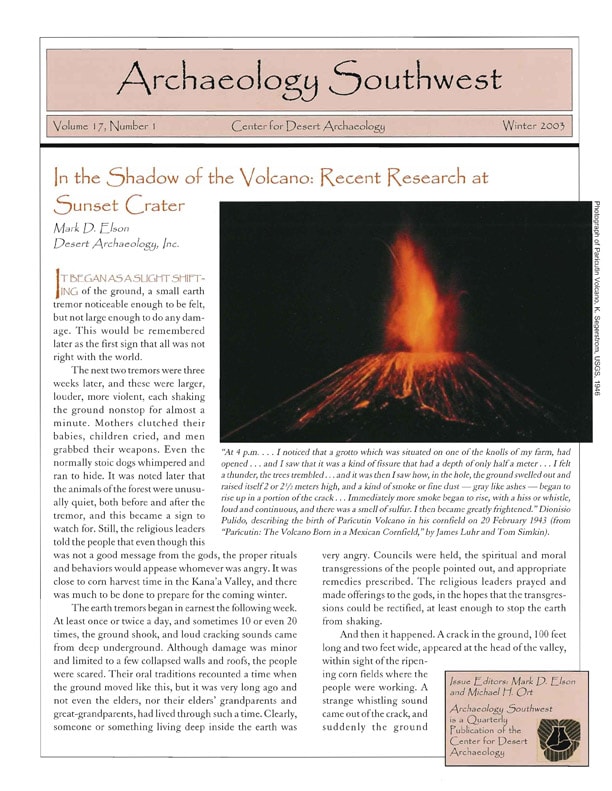In the Shadow of the Volcano: Recent Research at Sunset Crater
Archaeology Southwest Magazine Vol. 17, No. 1
Free PDF download
Mark D. Elson, Desert Archaeology, Inc.
The significance of Sunset Crater was first realized in the summer of 1930, when archaeologists from the Museum of Northern Arizona (MNA) uncovered a prehistoric pit structure sealed beneath a thick layer of black volcanic cinders. The excavation of this structure provided the first definitive evidence that Sunset Crater erupted during the prehistoric occupation of the Flagstaff area. It would not be an exaggeration to say that this finding forever changed the nature of northern Arizona archaeology.

Photograph of Paricutin Volcano, K. Segerstrom, USGS, 1946.
This issue of Archaeology Southwest explores Sunset Crater from several perspectives. Much of this research was undertaken through a highly productive collaboration between archaeologists from Desert Archaeology, Inc., and volcanologists and geomorphologists from Northern Arizona University. We were brought together by the Arizona Department of Transportation (ADOT), as part of the investigation of approximately 40 prehistoric sites along U.S. 89 just north of Flagstaff.
In this issue, volcanologist Michael Ort and I describe some of the results of our recent work at Sunset Crater. Much of this was funded by ADOT, though grants from the National Park Service and Western National Parks Association, and the assistance of the U.S. Geological Survey, have also aided our research. Archaeologist Chris Downum then presents the history of Sunset Crater dating, and particularly new information that is challenging what was once thought to be a well-established, if not sacred, A.D. 1064 date for the eruption. Geomorphologist Kirk Anderson discusses prehistoric agriculture in the Sunset Crater area, pointing out that theories derived in the 1930s by Dr. Harold S. Colton, the founder of MNA, are still very relevant today. Archaeologist Jeri DeYoung and Interpretative Specialist Carol Kruse examine the role of Sunset Crater in the National Park Service, discussing the history of the monument and outlining some of the research they have funded. Ort and I then describe our very recent research expedition to Parícutin Volcano. We hope this work will provide us with a chemical signature for that eruption, which we can then use to date the eruption of Sunset Crater. Although we do not yet have results from our work, the trip itself was highly illuminating and very exciting in terms of future research. Finally, Ort presents some new information on the Little Springs Volcano, an eruption on the north rim of the Grand Canyon that has only recently been found to have occurred at about the same time as Sunset Crater. The eruption of two volcanoes, located about 125 miles apart, would likely have had great meaning to the prehistoric inhabitants of the northern American Southwest.
There is no doubt that the eruption of Sunset Crater significantly affected the prehistoric people living in the Flagstaff area. The primary question we are asking is how these groups adapted to this catastrophic event, one that dramatically and permanently changed both the physical landscape and their ideological worldview. Previous research and our own archaeological investigations along U.S. 89 suggest that the small, relatively mobile groups living in the area at that time were in many ways pre-adapted to deal with the eruption, largely because they did not have a great deal of energy and resources invested in their habitation sites and agricultural field systems.
Our investigations indicate that a number of specific responses allowed a relatively quick adaptation to the eruption: (1) population movement; (2) use of new agricultural methods; (3) reliance on established kinship relationships; (4) changes in external exchange networks; and (5) initiation of volcano-related ritual behavior. While it is true that numerous villages and agricultural fields had to be abandoned, likely causing a fair amount of stress in the years immediately following the eruption, the eruption also had a beneficial side and opened up for settlement large areas of previously unfarmable land through the deposition of a “cinder mulch.” The movement of people into these newly productive areas eventually resulted in the spectacular ruins seen today at Wupatki National Monument, which contain some of the largest and most complex sites in the Flagstaff area.
Volcano eruptions are one of the most powerful and destructive forces known in the natural realm. They are ripe with symbolism, dramatically altering the landscape by spewing molten rock from deep within the earth. They are fire-breathing, earth-shaking creatures, who, accompanied by lightning and thunder, have the power to turn the day into night and the night into day. It is little wonder that volcanoes both fascinate and terrify mankind, as much so today as in the prehistoric past.
Issue Editors: Mark D. Elson and Michael H. Ort
Articles Include:
- Collaborative Research at Sunset Crater Volcano – Mark D. Elson and Michael H. Ort
- A Corn Rock Experiment
- A Brief Account of the History of Sunset Crater Dating – Christian Downum
- Sunset Crater and Cinder Mulch Agriculture – Kirk Anderson
- Sunset Crater and the National Park Service – Jeri DeYoung and Carol Kruse
- Paricutin Volcano Revisited – Mark D. Elson and Michael H. Ort
- Little Springs Volcano: A New Prehistoric Eruption – Michael H. Ort
Subscribe

